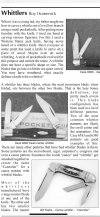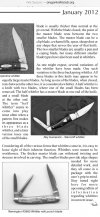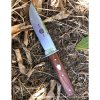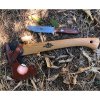You are using an out of date browser. It may not display this or other websites correctly.
You should upgrade or use an alternative browser.
You should upgrade or use an alternative browser.
Lets talk GEC!
- Thread starter rockgolfer
- Start date
- Joined
- Jul 3, 2019
- Messages
- 12,002
I have never assumed a "whittler" was two springs; nor have I ever seen it defined as such. In 2019, blade rub or the weak springs that sometimes come with splits are much more frowned upon than the number of springs - thus it is the right knife for the current users. I think one main blade looking across at two secondary blades will always be a whittler to most eyes. To be honest, the punch is more of a departure than the springs if you are historic or function minded.
Is this THE Mike Latham, responding to my little post? It’s an honor.
You’ve never seen the Whittler configuration debates? I feel like there’s a new one on the I internet every other year. Regardless, you’re right that this is a practical setup and it might answer some general call upon the wind to get rid of blade rub. Two spring and split spring whittlers always required that the main blade to opened first before deploying the opposite blades, in what one famous reviewer referred to as “proper Whittler etiquette “. Perhaps folks don’t like the hassle or don’t know about it.
Either way it looks like a winner.
The only definitions I’ve ever heard for whittler and stockman are the whittlers main blade is across from the secondaries and on a stockman the main blade is nest to one of the secondary blades. This is why when it’s a split back whittler they say “it’s a split back whittler” it’s almost never just assumed it’s a split back and if you do assume that you’re bound to make a disappointing purchase at some point. GEC has made at least a few three spring whittlers. The other thing I’ve seen is a two spring whittler with the springs running parallel and not split but the secondary blades being separated by a small piece of brass. There’s a name for that piece but it escapes me at the moment, I’m sure others know it, it’s also in two blade one spring designs.Now that you say that I guess I understand where the name could come from. Either way it’s referencing what are two different 2 spring 3 blade (typically) combos. I wonder if someone will be caught unaware when they buy one and get a three spring. Two spring / split back whittlers are much harder to make so I kind of feel like they should get the honorary title “Whittler”, but that’s just personal preference.
I hope whatever I’m doing isn’t being done wrong, I merely think there’s something to a name. I wonder if it’s going to mislead some of the less informed buyers. Of course naming conventions don’t ultimately really matter and I suppose anyone is welcome to call any product whatever they want. I know I don’t want to open up the “Hey, that’s not a true Whittler!” can of worms. I’ve seen those debates essentially end in disaster coming to the conclusion that there’s lots of things called Whittler and there is no strict practical guideline.
Just watch- I might end up with one these anyway; regardless of what it’s called or whether or not I use the punch a lot. I do love the pattern and I think they did a great job with blade placement. However if it came with a bottle opener/flat head screwdriver instead of a punch I could leave my SAK at home. That has some appeal to me.
- Joined
- Jul 3, 2019
- Messages
- 12,002
- Joined
- Jul 3, 2019
- Messages
- 12,002
The only definitions I’ve ever heard for whittler and stockman are the whittlers main blade is across from the secondaries and on a stockman the main blade is nest to one of the secondary blades. This is why when it’s a split back whittler they say “it’s a split back whittler” it’s almost never just assumed it’s a split back and if you do assume that you’re bound to make a disappointing purchase at some point. GEC has made at least a few three spring whittlers. The other thing I’ve seen is a two spring whittler with the springs running parallel and not split but the secondary blades being separated by a small piece of brass. There’s a name for that piece but it escapes me at the moment, I’m sure others know it, it’s also in two blade one spring designs.
I guess I just cut my teeth on the two spring varieties you describe here. I stand corrected if I’m the only one with this impression and misunderstanding.
- Joined
- May 22, 2011
- Messages
- 2,818
GEC can call the 29 anything they want to call it (they have designated other 3-springs as whittlers and certainly aren't the first to do so), but it would not fit in my whittler collection (I use Bernard Levine's definition of a whittler in Levine's Guide to Knives and their Values, 4th Edition aka LG4).
Whittler construction from LG4:
a. 3 blades
b. 2 springs
c. 1 large blade on one end
d. 2 small blades on the other end
e. each small blade bears on one of the springs
f. the large blade bears on both springs

Most whittlers have a center divider that separates the tangs of of the two smaller blades and that also separates the two springs for part of their length.

Other whittlers show no divider at the back. Often the two springs of this type are tapered and they are not separated at all. The tangs of the two small blades are separated by a very small divider at the end of the knife.
Additionally, the above type of construction is not split back, but is often erroneously called that.
Here is a split back...

Bernard Levine's photo of a Samuel Jackson knife, c.early-to-mid 1800s
with punch

Bernard Levine's photo of a Samuel Jackson knife, c.early-to-mid 1800s
Whittler construction from LG4:
a. 3 blades
b. 2 springs
c. 1 large blade on one end
d. 2 small blades on the other end
e. each small blade bears on one of the springs
f. the large blade bears on both springs

Most whittlers have a center divider that separates the tangs of of the two smaller blades and that also separates the two springs for part of their length.

Other whittlers show no divider at the back. Often the two springs of this type are tapered and they are not separated at all. The tangs of the two small blades are separated by a very small divider at the end of the knife.
Additionally, the above type of construction is not split back, but is often erroneously called that.
Here is a split back...

Bernard Levine's photo of a Samuel Jackson knife, c.early-to-mid 1800s
with punch

Bernard Levine's photo of a Samuel Jackson knife, c.early-to-mid 1800s
I highly doubt you’re the only one and it’s been a while but my first whittler was a 3 spring 54, and the reason I know about the two spring non split back one is that I bought one and was a little disappointed. There were not pictures of the back spring and I thought it was a true split back whittler.I guess I just cut my teeth on the two spring varieties you describe here. I stand corrected if I’m the only one with this impression and misunderstanding.
That would be a prescriptivist definition rather than a descriptive definition, proceed with caution if that’s what you go by. I’m going to make Star Wars LEGOs with my 4 yr old.GEC can call the 29 anything they want to call it (they have designated other 3-springs as whittlers and certainly aren't the first to do so), but it would not fit in my whittler collection (I use Bernard Levine's definition of a whittler in Levine's Guide to Knives and their Values, 4th Edition aka LG4).
Whittler construction from LG4:
a. 3 blades
b. 2 springs
c. 1 large blade on one end
d. 2 small blades on the other end
e. each small blade bears on one of the springs
f. the large blade bears on both springs

Most whittlers have a center divider that separates the tangs of of the two smaller blades and that also separates the two springs for part of their length.

Other whittlers show no divider at the back. Often the two springs of this type are tapered and they are not separated at all. The tangs of the two small blades are separated by a very small divider at the end of the knife.
Additionally, the above type of construction is not split back, but is often erroneously called that.
Here is a split back...

Bernard Levine's photo of a Samuel Jackson knife, c.early-to-mid 1800s
with punch

Bernard Levine's photo of a Samuel Jackson knife, c.early-to-mid 1800s
- Joined
- May 22, 2011
- Messages
- 2,818
Oh, I'm very cautious 


knifeswapper
Knife Peddler
- Joined
- Sep 3, 2004
- Messages
- 3,299
You’ve never seen the Whittler configuration debates? I feel like there’s a new one on the I internet every other year.
I have seen debates on every aspect of knives in days gone by. Generally someone writes a book or blog article setting up a definition for all to use and then there will be reference back to it some 30 years later as a true definition. You have to look no farther than this particular sub-forum to fire a debate between friends - try putting a clip on a Case trapper and watch the fur fly. If makers used only pre-defined setups for knives we wouldn't have any knives. And few blades are used today solely for the reasons they were created 75 years ago. Knife books of old are to be like cookbooks, as my mother says, simply recommendations. We owe those that came before us a debt of gratitude, but we can't let them also dictate all aspects of our future. Having said that, we have seen 3 backspring whittlers for decades.
- Joined
- Oct 28, 2010
- Messages
- 765
The voice of reason.I have seen debates on every aspect of knives in days gone by. Generally someone writes a book or blog article setting up a definition for all to use and then there will be reference back to it some 30 years later as a true definition. You have to look no farther than this particular sub-forum to fire a debate between friends - try putting a clip on a Case trapper and watch the fur fly. If makers used only pre-defined setups for knives we wouldn't have any knives. And few blades are used today solely for the reasons they were created 75 years ago. Knife books of old are to be like cookbooks, as my mother says, simply recommendations. We owe those that came before us a debt of gratitude, but we can't let them also dictate all aspects of our future. Having said that, we have seen 3 backspring whittlers for decades.
This appears to be a definitional dispute, not one based on function. I am certainly far from knowledgeable concerning what may or may not be a “Whittler”, but this seems to me to be a rather pointless argument. I think the #29 will be a very useful tool for regular carry and may grab one for that reason. I’m partial to the Stockman and Churchill patterns and this seems to fit in that category with the addition of a punch/awl.
And I have no need to carry around a cap lifter blade on a knife. I long ago figured out how to open a non-twist off cap with a closed knife blade.
mb>
Gold Member
- Joined
- Sep 24, 2014
- Messages
- 3,614
- Joined
- Jul 3, 2019
- Messages
- 12,002
I think it’s important to note I perceive this as a very friendly conversation, not so much an argument; much to this membership’s credit.
Going forward I’ll simply define Whittler by a folding pocket knife with one blade on one side and in between too blades on the other. And blade here will be used loosely to refer to some tool, cutting or otherwise.
Definitions are only meaningful if they are useful. Perhaps the term Whittler should be traded for something more accurate, since most knives can be used to whittle despite their pattern. Or we will simply describe the configuration each time.
The term stockman has even been used to describe 3 spring versions, which I wouldn’t expect. I think we should at least describe 3 spring versus 2 spring <<knife pattern here>> to prevent consumer confusion.
Going forward I’ll simply define Whittler by a folding pocket knife with one blade on one side and in between too blades on the other. And blade here will be used loosely to refer to some tool, cutting or otherwise.
Definitions are only meaningful if they are useful. Perhaps the term Whittler should be traded for something more accurate, since most knives can be used to whittle despite their pattern. Or we will simply describe the configuration each time.
The term stockman has even been used to describe 3 spring versions, which I wouldn’t expect. I think we should at least describe 3 spring versus 2 spring <<knife pattern here>> to prevent consumer confusion.
- Joined
- Jan 25, 2004
- Messages
- 1,214
Going forward I’ll simply define Whittler by a folding pocket knife with one blade on one side and in between too blades on the other...
Dang. All those knives I thought were Stockmen are really Whittlers?
LastRodeo
Platinum Member
- Joined
- Nov 2, 2013
- Messages
- 4,304
I like caplifters as much as the next guy, probably more than most. I just don’t think they belong on every knife. I understand you want this particular pattern with a caplifter. My point was, for every release GEC does (and every forum knife) someone wants it with a caplifter. GEC may morph into Great Eastern Caplifter and put one one every knife they make, but I hope not.Is this THE Mike Latham, responding to my little post? It’s an honor.
You’ve never seen the Whittler configuration debates? I feel like there’s a new one on the I internet every other year. Regardless, you’re right that this is a practical setup and it might answer some general call upon the wind to get rid of blade rub. Two spring and split spring whittlers always required that the main blade to opened first before deploying the opposite blades, in what one famous reviewer referred to as “proper Whittler etiquette “. Perhaps folks don’t like the hassle or don’t know about it.
Either way it looks like a winner.
LastRodeo i think a caplifter makes a really useful secondary for most people. That might be the reason for the popularity. I’d like one as a tertiary on exactly this blade combo.
- Joined
- Jul 3, 2019
- Messages
- 12,002
Dang. All those knives I thought were Stockmen are really Whittlers?
Haha, I was very careful to say in between two blades on the other side because it could be a stockman without it.
I found an older article about whittlers and it features one similar to the one that started this debate it’s the last photo. Here is the link to it it’s from an Oregon Knife Collectors newsletter http://www.oregonknifeclub.org/Newsletter 1201.pdf
For the record MerryMadMonk
i have absolute confidence that you are cautious, know your stuff, and know what you want to buy and where to find it. The word of warning was for those newer to the sickness that might not know so they can learn from the mistakes of those that have made them already.
MerryMadMonk
i have absolute confidence that you are cautious, know your stuff, and know what you want to buy and where to find it. The word of warning was for those newer to the sickness that might not know so they can learn from the mistakes of those that have made them already.
Edit: like the “Barlow’s” on the auction site that have regular bolsters, not bolsters that take up exactly 1/3 of the handle, that’s a different debate though.


For the record
Edit: like the “Barlow’s” on the auction site that have regular bolsters, not bolsters that take up exactly 1/3 of the handle, that’s a different debate though.


Elgatodeacero
Gold Member
- Joined
- Jan 5, 2014
- Messages
- 2,744
kamagong
Gold Member
- Joined
- Jan 13, 2001
- Messages
- 10,560
That’s a perfect example. Bowie knife? I don’t think so. We have no idea what Bowie’s knife looked like since it was never photographed. We do know from descriptions that it was a large knife with a > 9” blade. That tiny little thing is no bowie.
- Joined
- Oct 28, 2010
- Messages
- 765
I like this article. Whittlers, as with other knife monikers,is more of a general guidance than a definition. I could consider my Tidioute Congress Clerk Office Knife to be a half whittler, or a half Congress, or just an amazingly cool, historical pattern. Or all of the above.I found an older article about whittlers and it features one similar to the one that started this debate it’s the last photo. Here is the link to it it’s from an Oregon Knife Collectors newsletter http://www.oregonknifeclub.org/Newsletter 1201.pdf
For the recordMerryMadMonk i have absolute confidence that you are cautious, know your stuff, and know what you want to buy and where to find it. The word of warning was for those newer to the sickness that might not know so they can learn from the mistakes of those that have made them already.
Edit: like the “Barlow’s” on the auction site that have regular bolsters, not bolsters that take up exactly 1/3 of the handle, that’s a different debate though.
View attachment 1164997 View attachment 1164998


